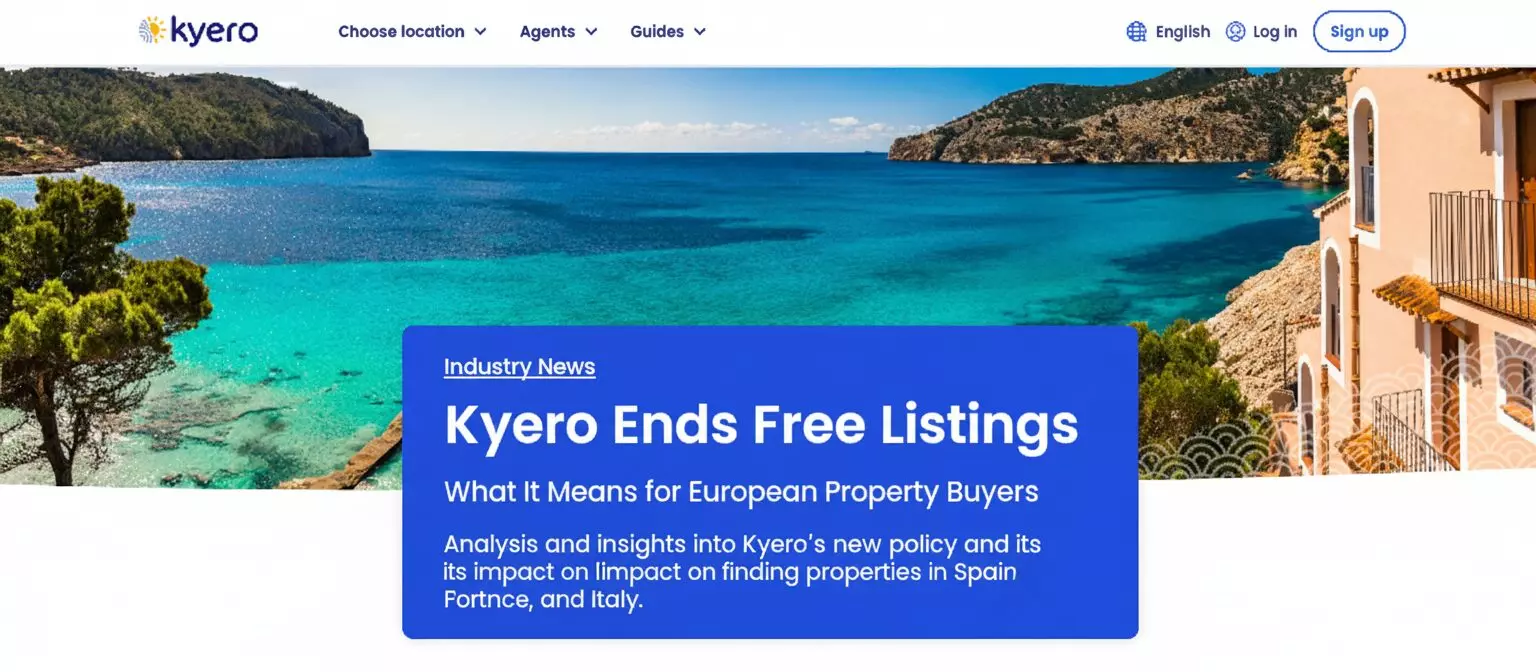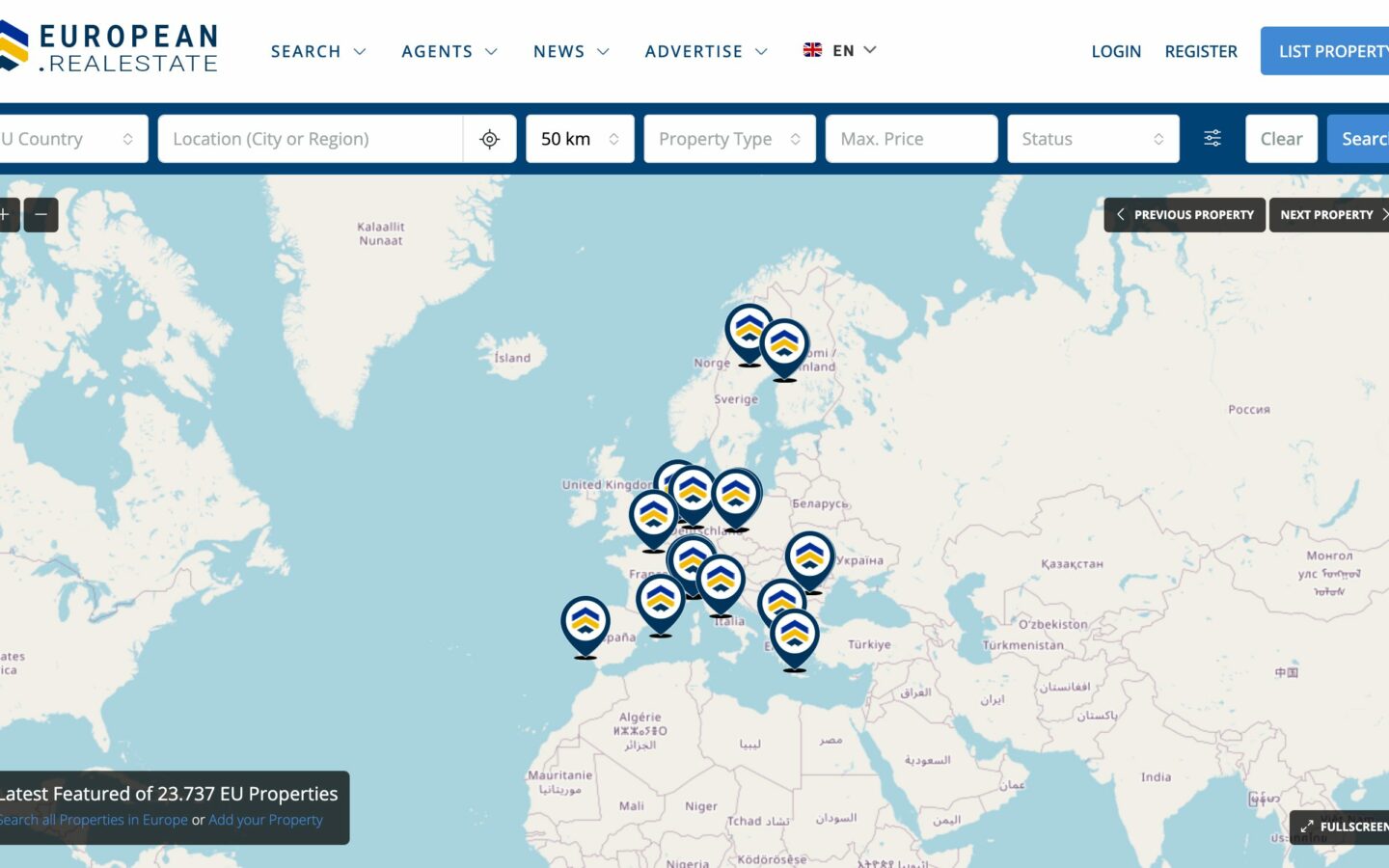If you’ve been browsing for your dream villa in Spain or a cozy apartment in Portugal, you’ve likely come across Kyero, one of Europe’s most popular international property portals. Recently, the platform announced a significant shift in its business model: they’re dropping free listings for agents and developers. This change, effective from their November 2025 announcement, marks a turning point in how property seekers will search for homes across Southern Europe. But what does this mean for you as a buyer? Will it make your property search easier or more complicated? In this article, we’ll break down the changes, explore how they affect your buying journey, and introduce you to alternative platforms like European.realestate that might better serve your needs.
Get one year Free Listings!
Subscribe to our newsletter and get 1 year listings + XML imports for free and enjoy a 100% discount on all listing placement packages, no strings attached!

The property search landscape is evolving rapidly, and understanding these platform changes can save you time, money, and frustration. Whether you’re a first-time buyer looking for a holiday home or an experienced investor expanding your portfolio, staying informed about where and how to find quality listings is crucial. Let’s dive into what Kyero’s new policy means for your European property dreams.
Kyero Ends Free Listings: What It Means for Buyers
Kyero’s decision to eliminate free listings represents a fundamental shift in their business strategy. For years, the platform allowed real estate agents to post basic listings without charge, which helped build an extensive database of properties across Spain, Portugal, France, and Italy. Now, all agents and developers must pay to advertise their properties, which Kyero claims will improve overall listing quality and reduce spam or outdated advertisements that often frustrated buyers.
For property buyers, this change has both positive and negative implications. On one hand, you’ll likely encounter fewer duplicate listings, abandoned properties, and outdated information that previously cluttered search results. On the other hand, smaller independent agents who relied on free listings may no longer advertise on Kyero, potentially limiting your access to hidden gems and locally-sourced properties that larger agencies might overlook. This is particularly relevant in rural areas of Spain or smaller Portuguese coastal towns where boutique agencies often have the best insider knowledge.
What’s Changing at Kyero?
The new paid-only model means every listing on Kyero will come from agents who have invested financially in their presence on the platform. According to the AIM Group report, this transition aims to create a more professional marketplace where serious sellers work with committed agents. Kyero is positioning itself as a premium platform rather than a comprehensive directory, which fundamentally changes its value proposition for users.
Practically speaking, you’ll notice several differences when searching on Kyero now. First, the total number of listings will decrease as smaller agents and private sellers who can’t justify the subscription costs leave the platform. Second, the listings that remain should theoretically be more current, with better photography, more detailed descriptions, and more responsive agents behind them. However, this also means you’re seeing a curated selection rather than the full market picture. For buyers who want comprehensive market coverage, relying solely on Kyero may no longer provide the complete view you need to make informed decisions.
How This Affects Your Property Search
Your property search strategy needs to adapt to this new reality. Previously, you might have relied on Kyero as your primary search tool, confident you were seeing most available properties in your target area. Now, you’ll need to diversify your search approach to ensure you’re not missing opportunities. This means actively checking multiple platforms, contacting local agents directly, and exploring alternative property portals that offer different business models.
The financial implications are indirect but worth considering. While you’re not paying Kyero directly as a buyer, the agents’ subscription costs will likely be factored into their business expenses, potentially affecting commission structures or property prices. More significantly, if fewer agents advertise on Kyero, competition among sellers decreases, which could mean less negotiating power for you. Smart buyers will compensate by widening their search net and comparing listings across multiple platforms to maintain leverage in negotiations.
Fewer Listings, But Higher Quality
Kyero’s bet is that quality trumps quantity, and there’s merit to this argument. Anyone who’s spent hours scrolling through property listings knows the frustration of finding the perfect home, only to discover it sold six months ago or never actually existed at the advertised price. Paid listings create accountability because agents have financial skin in the game and reputational risks if they post misleading information.
However, “higher quality” doesn’t automatically mean “better for buyers.” A polished listing with professional photos might look impressive, but it doesn’t necessarily represent better value than a modest listing from a small local agent who knows the neighborhood intimately. First-time buyers especially should remember that presentation quality and property quality are different things. The charming fixer-upper with amateur photos might be a better investment than the staged showpiece with professional marketing. This is where platforms with diverse listing types, including free options, can provide more balanced market exposure.
Comparing Kyero with European.realestate
When evaluating alternatives to Kyero, European.realestate presents an interesting comparison. While Kyero focuses primarily on Southern European markets with a paid-listing model, European.realestate takes a broader approach across the continent with different pricing structures that may be more inclusive for various types of sellers and agents.
Here’s a practical comparison of both platforms:
| Feature | Kyero | European.realestate |
|---|---|---|
| Geographic Coverage | Spain, Portugal, France, Italy | Pan-European coverage |
| Listing Model | Paid subscriptions only | Mixed model options |
| Agent Types | Primarily established agencies | Diverse agent sizes |
| Property Types | Residential focus | Residential and commercial |
| Search Filters | Country-specific expertise | Broader European search |
| Mobile Experience | Established app | Modern responsive design |
| Market Insights | Southern Europe focused | Continental perspective |
European.realestate offers several advantages for buyers seeking comprehensive market coverage. Their platform includes listings from a wider variety of sources, including smaller agents who might not afford Kyero’s subscription fees. This is particularly valuable if you’re comparing markets across different countries or considering less mainstream locations. For example, if you’re weighing a coastal property in Portugal against something in Croatia or Greece, European.realestate provides a single platform for comparison rather than requiring multiple specialized sites.
The platform’s approach to listing diversity means you’ll see a broader range of properties at different price points. While this might mean encountering some lower-quality listings, it also ensures you’re not missing opportunities from legitimate sellers who simply can’t justify premium listing fees. For experienced buyers who know how to evaluate listings critically, this comprehensive approach often yields better results than curated-only platforms.
Practical Tips for Navigating the New Property Search Landscape
Given these platform changes, here are concrete strategies to optimize your European property search:
Diversify Your Search Platforms
- Use Kyero for professionally-presented properties from established agents
- Check European.realestate for broader market coverage
- Explore local country-specific portals (Idealista for Spain, Immoweb for Belgium, etc.)
- Join Facebook groups for expat communities in your target areas
- Contact local agents directly, especially in smaller towns
Verify Listing Information
- Cross-reference properties across multiple platforms
- Use Google Street View to verify neighborhood conditions
- Check local property registries where available
- Request recent utility bills to confirm running costs
- Ask for proof of legal documentation before committing
Understand Country-Specific Regulations
Each European country has unique property buying requirements that affect your search strategy. In Spain, you’ll need an NIE (foreigner identification number) before purchasing, which can take several weeks to obtain. Portugal offers attractive tax incentives for foreign buyers through the Non-Habitual Resident program, but you need to understand the qualification criteria before making offers. France has strict inheritance laws that affect property ownership structures, particularly for married couples or those with children from previous relationships.
Germany requires notary involvement for all property transactions, adding specific costs and timelines to your purchase. Italy’s property market varies dramatically by region, with different documentation requirements in the north versus south. Greece recently simplified its Golden Visa program, making property investment more attractive, but bureaucratic processes can still be lengthy. Understanding these country-specific factors helps you evaluate whether listings on any platform are realistically achievable given your circumstances.
Making the Most of Multiple Platforms
Rather than viewing Kyero’s changes as a setback, consider them an opportunity to develop a more sophisticated search strategy. Professional property investors rarely rely on a single source, and neither should you. Create a systematic approach where you check multiple platforms weekly, save interesting listings with notes about their source, and track price changes over time.
Set up search alerts on both Kyero and European.realestate with identical criteria to compare what each platform offers. You’ll quickly notice differences in listing volume, property types, and agent responsiveness. This comparative approach gives you market intelligence that single-platform users miss. For example, if you notice a property appears on European.realestate but not on Kyero, you might have less competition from other buyers, potentially giving you negotiating advantages.
Frequently Asked Questions
Will Kyero’s paid-only model make properties more expensive?
Not directly. Property prices are determined by market conditions, not listing platforms. However, agents’ increased marketing costs might indirectly influence their pricing strategies or commission structures. The bigger impact is on market visibility rather than property values themselves.
Should I stop using Kyero entirely?
No, Kyero still offers value, particularly for professionally-marketed properties from established agencies in Spain and Portugal. Just don’t rely on it exclusively. Combine it with other platforms like European.realestate for comprehensive market coverage.
Are free listings always lower quality?
Absolutely not. Many excellent properties are listed by small, reputable agents who simply can’t justify expensive platform subscriptions. Free listings require more due diligence from buyers, but they often represent genuine opportunities, especially in less competitive markets.
How do I know if I’m seeing all available properties in my target area?
You can’t be 100% certain, which is why using multiple platforms is essential. Contact several local agents directly, check country-specific portals, and join local expat forums where properties are sometimes advertised before hitting major platforms.
What’s the biggest mistake buyers make when using property portals?
Trusting a single source and failing to verify information independently. Always cross-reference listings, verify agent credentials, and conduct thorough due diligence regardless of how professional a listing appears.
Does European.realestate cover the same countries as Kyero?
European.realestate actually covers more countries across Europe, while Kyero specializes in Southern European markets. If you’re specifically focused on Spain or Portugal, Kyero’s specialization offers depth. For broader European searches, European.realestate provides wider coverage.
Kyero’s transition to a paid-only listing model represents a significant shift in the European property search landscape, but it doesn’t have to derail your home-buying dreams. By understanding what’s changing and adapting your search strategy accordingly, you can actually become a more informed and effective buyer. The key is diversification: use Kyero for its curated, professionally-presented listings, but complement it with platforms like European.realestate that offer broader market coverage and different listing types. Remember that the best property deal isn’t always the one with the most polished presentation, it’s the one that genuinely meets your needs at the right price in the right location.
Whether you’re a first-time buyer searching for a vacation home or an experienced investor building a European portfolio, success comes from thorough research across multiple sources. Don’t let platform changes limit your options. Instead, use them as motivation to develop a more comprehensive search strategy that gives you true market insight. The European property market remains full of opportunities for informed buyers who know where to look and how to evaluate what they find. Your dream European home is out there, you just need to cast a wide enough net to find it.
Keywords: Kyero property listings, European property search, buying property in Europe, European.realestate, Spain property market, Portugal real estate, property portals comparison, international property platforms, European home buying, real estate listing sites






Join The Discussion